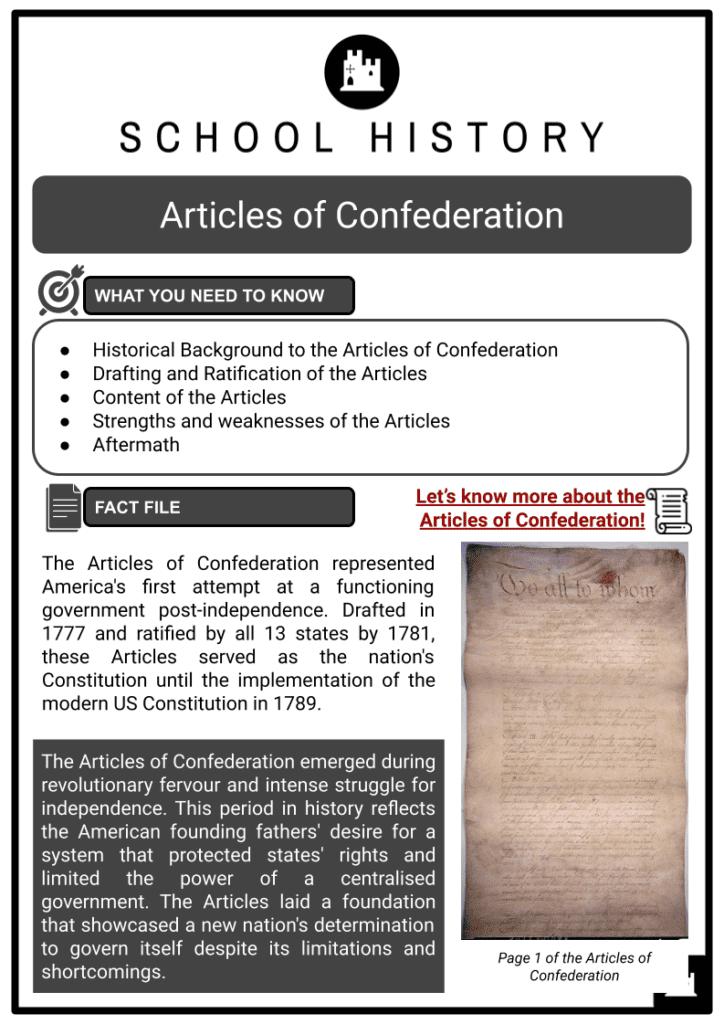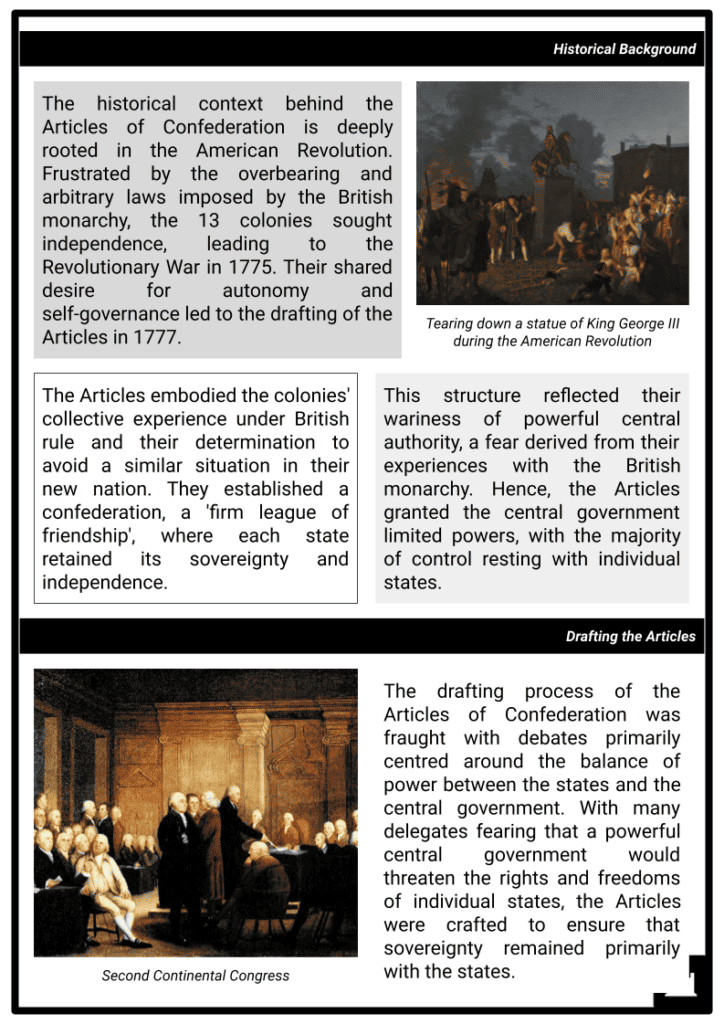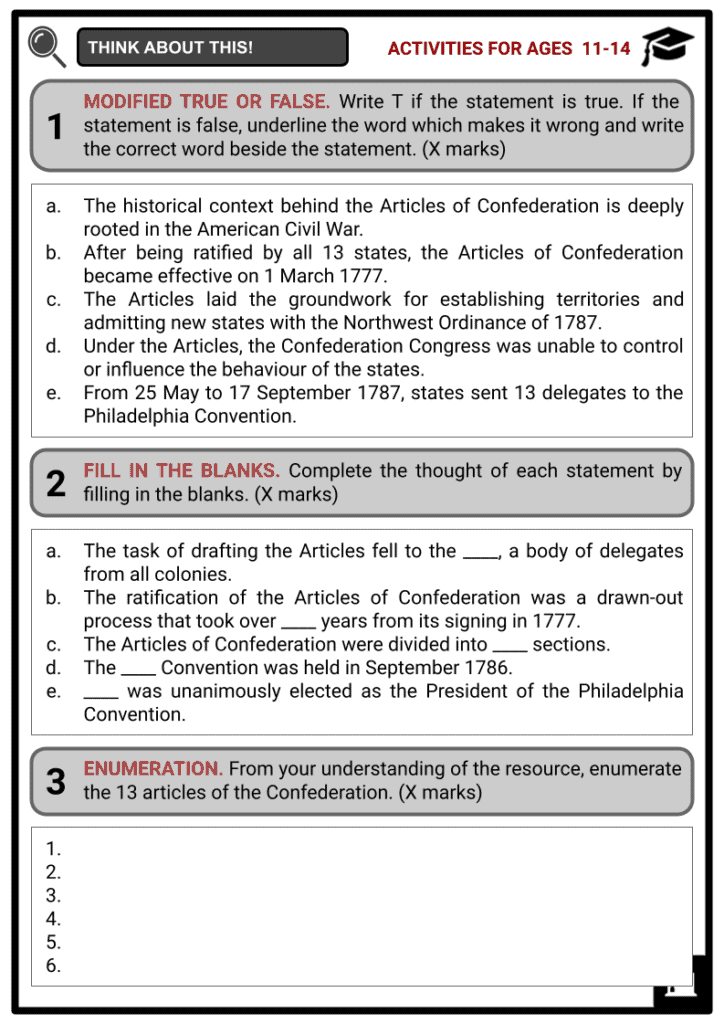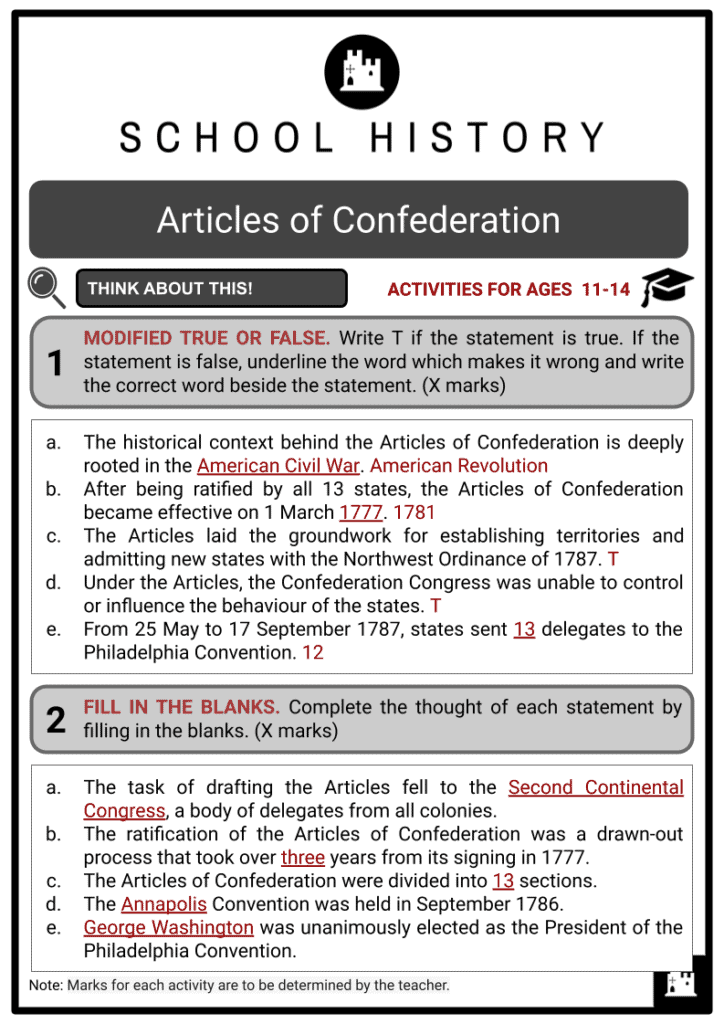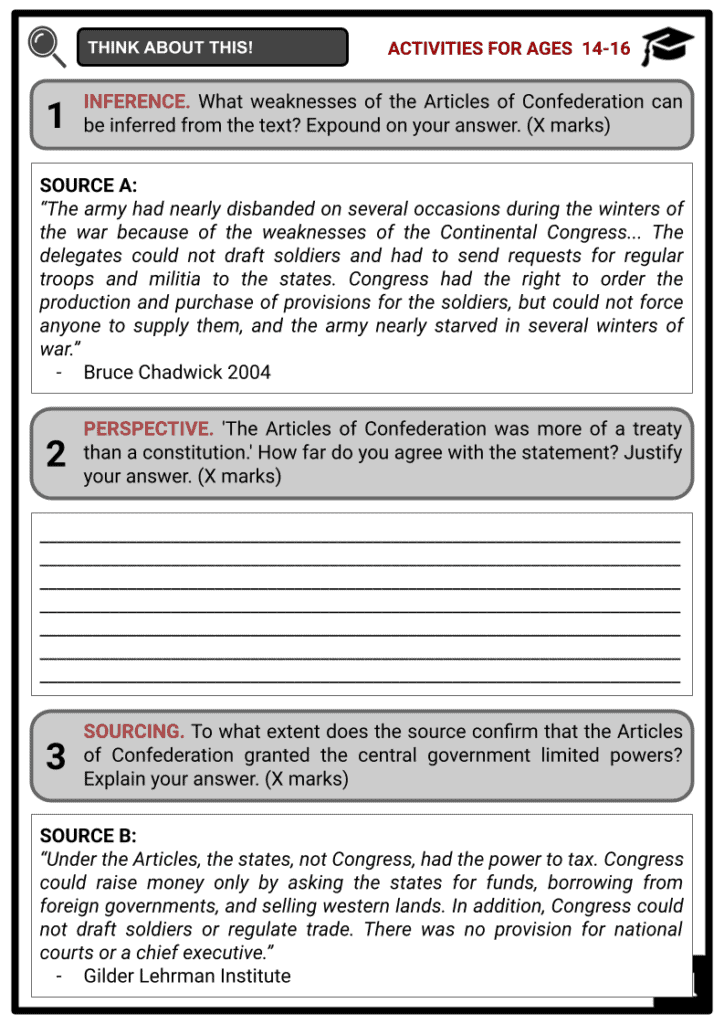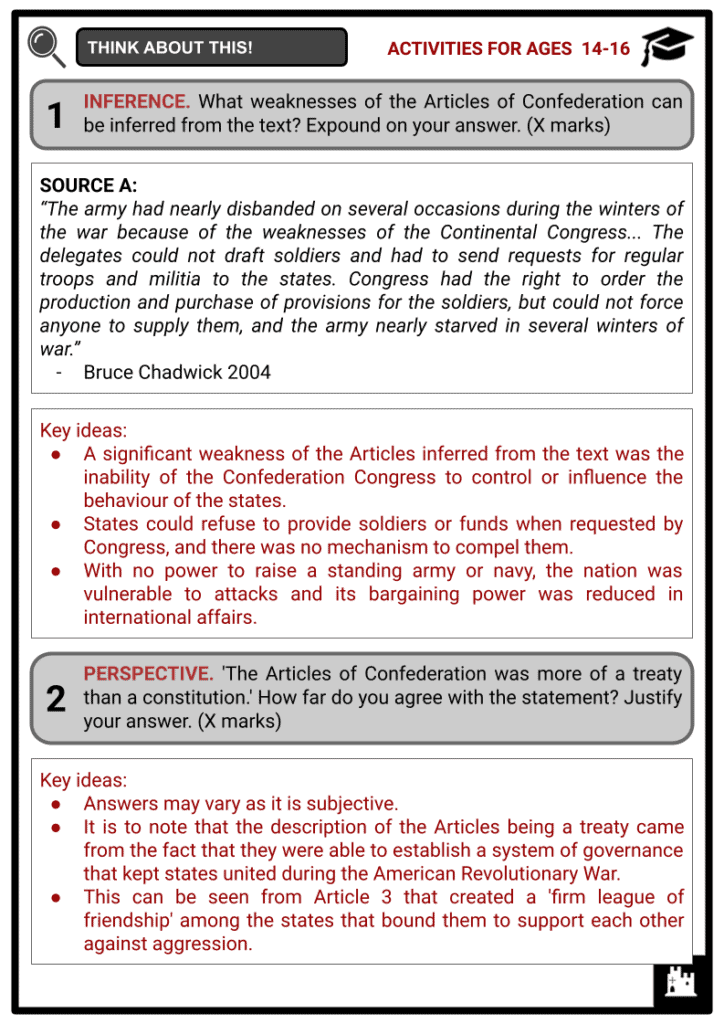Articles of Confederation Worksheets
Do you want to save dozens of hours in time? Get your evenings and weekends back? Be able to teach about the Articles of Confederation to your students?
Our worksheet bundle includes a fact file and printable worksheets and student activities. Perfect for both the classroom and homeschooling!
Summary
- Historical Background to the Articles of Confederation
- Drafting and Ratification of the Articles
- Content of the Articles
- Strengths and weaknesses of the Articles
- Aftermath
Key Facts And Information
Let’s know more about the Articles of Confederation!
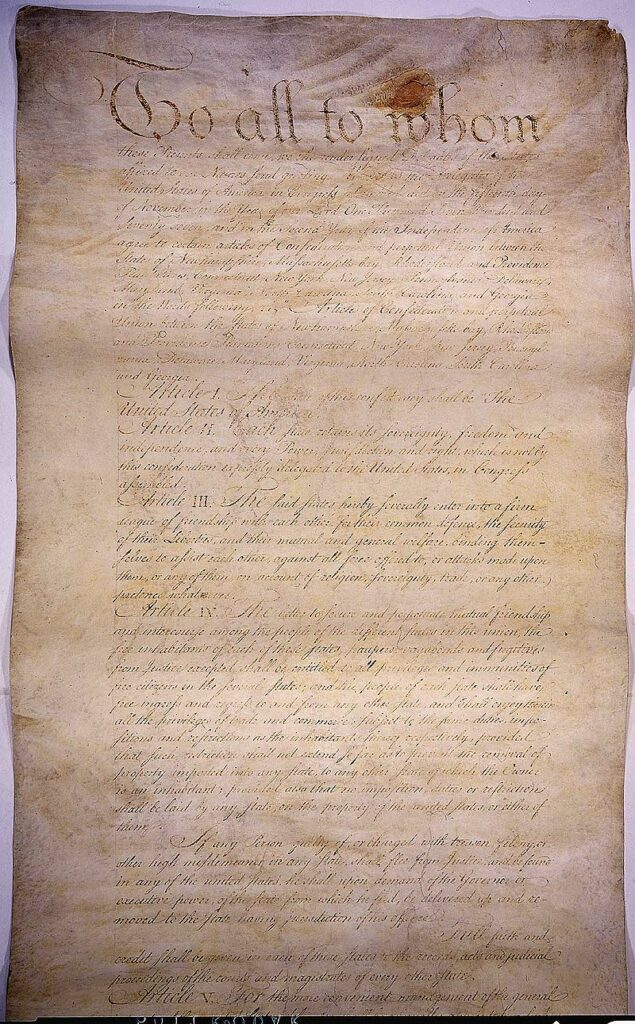
The Articles of Confederation represented America's first attempt at a functioning government post-independence. Drafted in 1777 and ratified by all 13 states by 1781, these Articles served as the nation's Constitution until the implementation of the modern US Constitution in 1789. The Articles of Confederation emerged during revolutionary fervour and intense struggle for independence. This period in history reflects the American founding fathers' desire for a system that protected states' rights and limited the power of a centralised government. The Articles laid a foundation that showcased a new nation's determination to govern itself despite its limitations and shortcomings.
Historical Background
- The historical context behind the Articles of Confederation is deeply rooted in the American Revolution. Frustrated by the overbearing and arbitrary laws imposed by the British monarchy, the 13 colonies sought independence, leading to the Revolutionary War in 1775. Their shared desire for autonomy and self-governance led to the drafting of the Articles in 1777.
- The Articles embodied the colonies' collective experience under British rule and their determination to avoid a similar situation in their new nation. They established a confederation, a 'firm league of friendship', where each state retained its sovereignty and independence.
- This structure reflected their wariness of powerful central authority, a fear derived from their experiences with the British monarchy. Hence, the Articles granted the central government limited powers, with the majority of control resting with individual states.
Drafting the Articles
- The drafting process of the Articles of Confederation was fraught with debates primarily centred around the balance of power between the states and the central government. With many delegates fearing that a powerful central government would threaten the rights and freedoms of individual states, the Articles were crafted to ensure that sovereignty remained primarily with the states.
- The task of drafting the Articles fell to the Second Continental Congress, a body of delegates from all colonies. The committee was made up of one representative from each of the 13 states:
- John Dickinson (Pennsylvania, chairman of the committee)
- Samuel Adams (Massachusetts)
- Robert R Livingston (New York)
- Button Gwinnett (Georgia)
- Stephen Hopkins (Rhode Island)
- Josiah Bartlett (New Hampshire)
- Joseph Hewes (North Carolina)
- Thomas Nelson (Virginia)
- Thomas McKean (Delaware)
- Thomas Stone (Maryland)
- Roger Sherman (Connecticut)
- Edward Rutledge (South Carolina)
- Francis Hopkinson (New Jersey)
- The committee initially appointed to draft the Articles faced a formidable task, as they had to reconcile the various interests and perspectives of the different colonies. Key figures in this process included John Dickinson, who authored the initial draft, and Benjamin Franklin, who provided crucial insights and revisions.
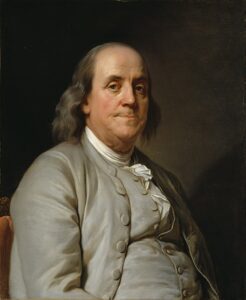
Benjamin Franklin - The drafting process was characterised by extensive deliberation and compromise. The goal was to create a document that balanced the need for collective defence and unity with the desire of states to preserve their sovereignty. This led to a confederal structure where the central government had limited powers, and important decisions often required the unanimous consent of all states.
Ratification of the Articles
- The ratification of the Articles of Confederation was a drawn-out process that took over three years from its signing in 1777. This was due to the requirement of unanimous approval from all 13 states, a high bar that led to numerous delays. Delays were caused by disputes over voting, representation and control of western lands.
- The first state to ratify was Virginia, just five days after the signing. However, the final state, Maryland, did not ratify until 1781. Maryland's delay in ratification was due to its concerns about the control of western territories by larger, more populous states.
- The state argued for these lands to be turned over to the central government to ensure equal access and distribution among all states. Only after the larger states relinquished their claims did Maryland finally ratify the Articles, marking the official formation of the United States as a confederation. After being ratified by all 13 states, the Articles of Confederation became effective on 1 March 1781.
- The dates below indicate when the states ratified the Articles of Confederation:
- Virginia - 16 December 1777
- South Carolina - 5 February 1778
- New York - 6 February 1778
- Rhode Island - 9 February 1778
- Connecticut - 12 February 1778
- Georgia - 26 February 1778
- The ratification process highlighted the deep-seated regional differences that existed among the states. These divisions, especially over the control of western lands, underscored the difficulties in forging a unified national identity and policy.
- Though labour-intensive and time-consuming, the process leading towards the Articles ratification resulted in a document that, for the first time in history, united the colonies under a joint government. Despite its shortcomings and eventual replacement by the Constitution, drafting the Articles of Confederation marked an essential step in the American journey towards self-governance.
Content of the Articles
- The Articles of Confederation established a framework for a national government with limited powers, leaving most of the authority to the individual states. The Articles swore firmly that 'Each state retains its sovereignty.' They were divided into 13 sections, outlining the powers and responsibilities of the national government.
- The 13 articles of the Confederation were as follows:
- The First Article established the name of the new Confederation: 'The United States of America'.
- The Second Article asserted the sovereignty of the states, declaring them independent and self-governing in all matters not explicitly delegated to the national government.
- The Third Article formed a 'firm league of friendship' among the states for mutual defence, securing liberties and their shared welfare, binding them to support each other against aggression.
- The Fourth Article guaranteed the people's freedom of movement – anyone could pass freely between states, excluding 'paupers, vagabonds, and fugitives from Justice'. All people were entitled to the same rights and privileges of the state where they travelled.
- The Fifth Article stipulated one vote per state in the 'Congress of the Confederation' (regardless of size or population).
- The Sixth Article restricted the states from forming foreign alliances without the consent of Congress and limited the establishment of standing armies and navies.
- The Seventh Article determined that when a state needed to provide troops to the national military, officers of rank were to be appointed by the state legislature.
- The Eighth Article detailed how the federal government's expenses were to be funded by the states based on the real property value of each.
- The Ninth Article defined the central government's rights: declaring war, regulating foreign affairs and settling state disputes.
- The Tenth Article established a committee to run the country when Congress was not in session.
- The Eleventh Article asserted that Canada was allowed to enter the Union if they desired, but no other colony could without the consent of nine states.
- The Twelfth Article affirmed that the Confederation accepted war debt incurred by Congress before the existence of the Articles.
- The Thirteenth Article declared that the Articles were perpetual and could only be altered by approval of Congress and ratification by all the state legislatures.
Strengths of the Articles of Confederation
- Despite their shortcomings, the Articles of Confederation had their distinctive strengths. They established a system of governance that kept the states united during the war. The Articles empowered the national government to negotiate the Treaty of Paris in 1783, which officially ended the American Revolutionary War and recognised the United States as an independent nation.

Postage stamp commemorating the Articles of Confederation - The Articles also laid the groundwork for establishing territories and admitting new states with the Northwest Ordinance of 1787. They facilitated the passage of these significant policies, which led to organised settlement and statehood for western territories.
- The Articles of Confederation played a crucial role in creating a standardised set of laws, promoting unity and cooperation amongst the states. This was particularly evident in handling foreign affairs, where the Articles provided for a unified front, centralising diplomatic interactions and negotiations.
- The Articles also facilitated free movement amongst the states, helping to foster economic growth and cultural exchange. They promoted a certain level of free trade between states, removing the concept of individual state tariffs that could have stifled economic growth and interstate commerce. This was a significant leap towards creating a single, unified market, an integral concept of the modern American economy.
- Lastly, the Articles of Confederation were instrumental in establishing a republic where power lies in the hands of the people and their elected representatives. This represented a significant departure from the monarchical rule they had been under and set the stage for the democratic principles that would later be enshrined in the US Constitution.
Weaknesses of the Articles of Confederation
- Nevertheless, the Articles of Confederation had many significant weaknesses. They failed to grant Congress the power to levy taxes, regulate commerce or enforce laws. Each state was given one vote, regardless of its size or population, leading to imbalances in representation.
- The Articles faced issues due to a lack of central leadership. The lack of an executive branch to enforce laws, and a judicial branch to interpret them, left the country without any means to ensure the implementation of laws passed by Congress, or to resolve disputes among states. This created a void in the governmental structure. With the central government lacking power to enforce treaties, the nation had a weak international standing, resulting in a lack of respect and recognition from other nations.
- The Articles also failed to provide for a sound financial foundation for the country. The federal government had no power to levy taxes and was reliant on states for funding. This led to a chronic shortage of funds, hindering the government's ability to manage national affairs. The lack of a national currency under the Articles resulted in economic disarray, with each state issuing its own currency. This impeded trade and created financial confusion. Moreover, the Articles did not provide the central government with the power to regulate trade between states, leading to economic disputes.
- Another significant weakness was the inability of the Confederation Congress to control or influence the behaviour of the states. States could refuse to provide soldiers or funds when requested by Congress, and there was no mechanism to compel them. With no power to raise a standing army or navy, the nation was vulnerable to attacks and its bargaining power was reduced in international affairs.
- The Articles even made it virtually impossible to adapt or change due to the requirement of unanimous consent for amendments. This inflexibility of the Articles was particularly detrimental in times of national crisis, such as the Revolutionary War, when swift and decisive action was needed.
- While the Articles of Confederation served as a crucial step towards the formation of the United States, they were riddled with structural weaknesses that ultimately led to their replacement by the US Constitution.
The Aftermath of the Articles of Confederation
- The deficiencies of the Articles of Confederation led to widespread dissatisfaction and unrest among the people, which sparked the need for a stronger central government. This sentiment was effectively captured in the Annapolis Convention of 1786, which recommended a constitutional convention to revise the Articles.
- The Annapolis Convention, held in September 1786, was a significant event that brought the structural deficiencies of the Articles of Confederation to the forefront. Initially, the Convention aimed to address the commercial disputes plaguing the country. Delegates from just five states — New Jersey, New York, Pennsylvania, Delaware and Virginia — showed up, demonstrating the widespread apathy and disunity among the states.
- However, the limited attendance did not deter the delegates who were present. Spearheaded by Alexander Hamilton and James Madison, they penned a report to Congress and the states, expressing the urgent need for changes to the Articles of Confederation.
- The Annapolis Convention laid the groundwork for the Philadelphia Convention (also called the Constitutional Convention). The Convention was mandated to develop proposals for the revision of the Articles. Despite the initial intention to revise the Articles based on its weaknesses, the delegates agreed to discard it and propose a new Constitutional framework.
- From 25 May to 17 September 1787, in the old Pennsylvania State House in Philadelphia, states sent 12 delegates to the Philadelphia Convention, with Rhode Island boycotting it as they protested the idea of having a strong central government. The presence of George Washington, who was unanimously elected to be the President of the Convention, was significant in mobilising the support of the states.
- The Constitution addressed many of the shortcomings of the Articles, creating a strong federal government with powers of taxation, commerce regulation, and law enforcement. It also established a system of checks and balances among the three branches of government: the legislative, executive and judicial branches. The ratification of the Constitution signalled the end of the Confederation era, marking a new chapter in the pursuit of American independence and democratic governance.
- Despite the abandonment of the Articles, their impact continued to be felt in the political and social fabric of the nation. While flawed, the Articles laid the foundation for America's current system of government.
Image Sources
- https://upload.wikimedia.org/wikipedia/commons/thumb/b/b4/Articles_page1.jpg/800px-Articles_page1.jpg
- https://upload.wikimedia.org/wikipedia/commons/thumb/8/87/Joseph_Siffrein_Duplessis_-_Benjamin_Franklin_-_Google_Art_Project.jpg/800px-Joseph_Siffrein_Duplessis_-_Benjamin_Franklin_-_Google_Art_Project.jpg
- https://upload.wikimedia.org/wikipedia/commons/a/a8/Articles_of_Confederation_13c_1977_issue.JPG
Frequently Asked Questions
- What were the Articles of Confederation?
The Articles of Confederation were the United States' first constitution, serving as the supreme law of the land from 1781 to 1789. They established a loose alliance of the thirteen American states during and after the Revolutionary War.
- What are the 3 main points of the Articles of Confederation?
State Autonomy: States had sovereignty and independence, with limited powers given to the central government.
Unicameral Congress: A one-house legislature (Continental Congress) gave each state one vote, promoting equal representation.
Limited Central Powers: The central government had limited authority, including foreign affairs, but lacked taxing power and control over interstate commerce. - Why were the Articles of Confederation created?
The Articles were created to provide a framework for governance among the newly independent states. They were intended to coordinate common efforts, such as defence against British forces while preserving individual state sovereignty.

